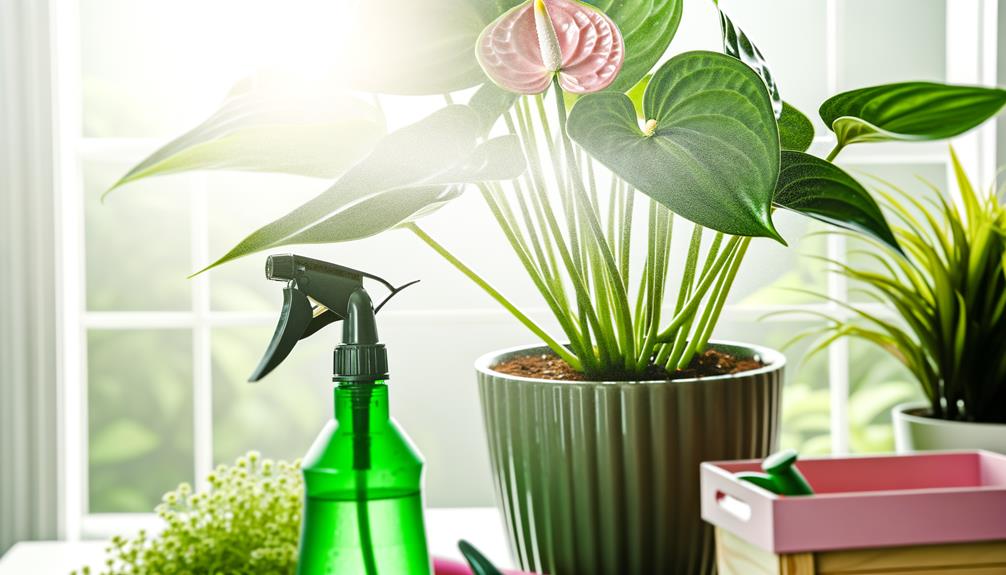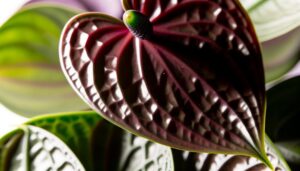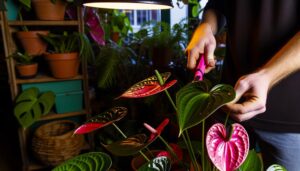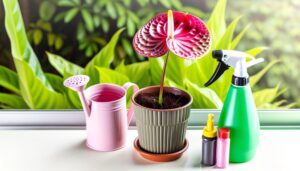Complete Guide to Caring for Anthurium Evita Pink
To care for Anthurium Evita Pink, provide bright, indirect light around 10,000-20,000 lux. Water when the top 1-2 inches of soil are dry, using distilled or rainwater at room temperature every 5-7 days during growth and every 10-14 days in winter.
Use well-draining soil with a pH of 5.5-6.5 and fertilize with balanced liquid fertilizer every 6-8 weeks. Maintain temperatures between 65-80°F and humidity levels of 70-80%.
Address yellowing leaves and root decay by adjusting light and watering. For a more detailed understanding of each step, continue exploring our guide.

Key Takeaways
- Place Anthurium Evita Pink in bright, indirect light, avoiding direct sunlight.
- Water with distilled or rainwater when the top 1-2 inches of soil are dry.
- Use well-draining soil rich in organic matter with a pH of 5.5 to 6.5.
- Maintain temperature between 65-80°F and humidity levels around 70-80%.
- Fertilize every 6-8 weeks with a balanced liquid fertilizer.
Light Requirements
Anthurium Evita Pink thrives most in bright, indirect light, needing about 10,000 to 20,000 lux for best growth. You'll want to place it near a window with filtered sunlight or use sheer curtains to scatter direct rays.
Make sure the light source is consistent; fluctuations can stress the plant, hindering ideal photosynthesis. If natural light is insufficient, consider using fluorescent lights, keeping them about 12 inches above the plant.
Monitor the leaf coloration closely: deep green indicates good light levels, while yellowing suggests too much light. By maintaining these precise lighting conditions, you'll enhance the plant's photosynthetic efficiency, boosting its lush foliage and vibrant pink blooms.
Watering Guidelines
Proper light isn't the only key element; maintaining the correct watering schedule secures the Anthurium Evita Pink's health and vibrant appearance. Water your plant when the top 1-2 inches of soil feel dry to the touch. Use distilled or rainwater at room temperature to avoid mineral buildup. Aim to moisten the soil evenly without waterlogging it; excessive moisture can lead to root rot.
During the growing season, water every 5-7 days, but in winter, reduce this to every 10-14 days. Monitoring humidity is equally essential; keep it between 60-80% to mimic tropical conditions. For best results, mist the leaves regularly and place a humidity tray nearby. This routine guarantees your Anthurium thrives, displaying its signature pink blooms.
Soil and Fertilization
To achieve maximum growth and vibrant blooms, select a well-draining soil mix rich in organic matter, like a combination of peat, perlite, and orchid bark. Aim for a soil pH between 5.5 and 6.5 to optimize nutrient uptake. Fertilize every 6-8 weeks using a balanced liquid fertilizer, diluted to half strength.
| Component | Ratio | Purpose |
|---|---|---|
| Peat | 40% | Retains moisture |
| Perlite | 30% | Secures aeration |
| Orchid Bark | 30% | Offers drainage |
Monitor the soil's consistency, checking it never becomes waterlogged. An overabundance of nutrients can result in root burn, so always adhere to recommended dosages. Regularly inspect for signs of nutrient deficiency or toxicity, adjusting your fertilization routine accordingly.
Temperature and Humidity
Maintaining a temperature range between 65-80°F and ensuring humidity levels around 70-80% will create an ideal environment for your Anthurium Evita Pink to thrive.
Utilize a digital hygrometer to monitor humidity precisely, and consider employing a humidifier if necessary.
Position your plant away from drafts and sudden temperature fluctuations, as these can stress the foliage. During colder months, keep it away from windows and doors that might let in cold air.
To maintain peak humidity, mist the leaves with distilled water or place a water tray nearby. These steps will mimic the tropical conditions Anthurium Evita Pink naturally prefers, promoting vigorous growth and vibrant blooms.
Common Issues and Solutions
Anthurium Evita Pink can face several issues such as yellowing leaves, root decay, and pest invasions, each requiring specific solutions to safeguard the plant's health and longevity. Yellowing leaves often result from insufficient light; provide bright, indirect light and maintain soil moisture at 50-60%.
Root decay stems from overwatering; guarantee well-draining soil and avoid water stagnation. To combat pest infestations like aphids and spider mites, use a neem oil solution (5ml per liter of water) and apply bi-weekly.
Regularly inspect the plant for early signs of distress and adjust care routines promptly. With meticulous attention and precise adjustments, you'll optimize your Anthurium Evita Pink thrives, displaying its vibrant, pink blooms in peak health.
Conclusion
In sum, nurturing your Anthurium Evita Pink is like conducting a symphony of light, water, soil, and temperature.
By placing it in bright, indirect light, watering when the top inch of soil is dry, and keeping it in a humid, warm environment, you'll see it flourish.
Addressing common issues promptly guarantees your plant remains a vibrant masterpiece.
Follow these guidelines closely, and your Anthurium will reward you with a cascade of enchanting pink blooms.






